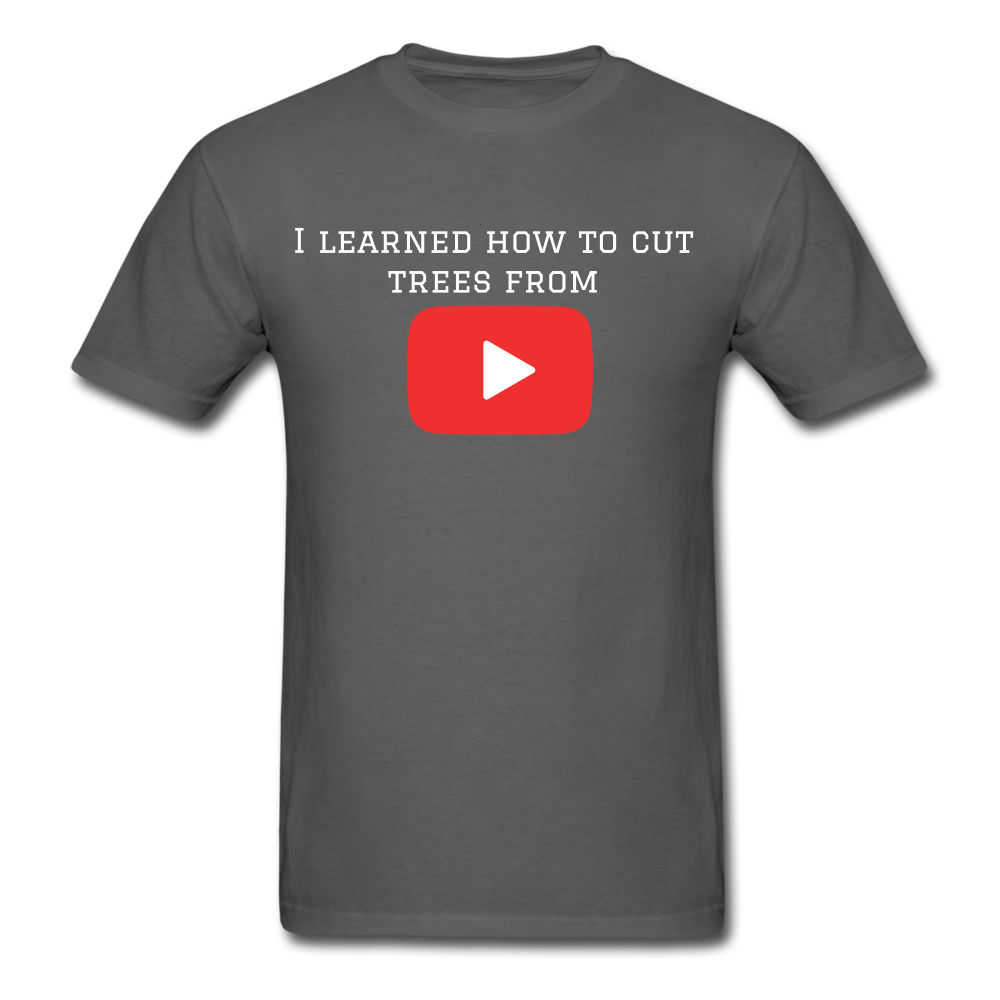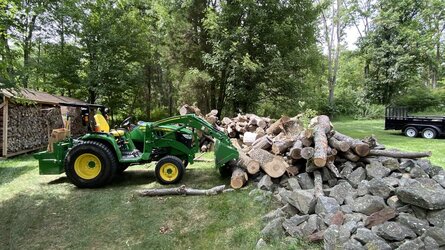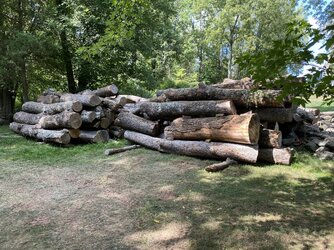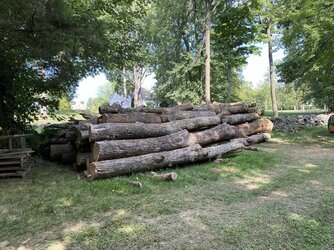Was doing some research about properly felling trees, and came across this last night. I found it pretty informative!
Tree Felling
- Thread starter RomanW
- Start date
-
Active since 1995, Hearth.com is THE place on the internet for free information and advice about wood stoves, pellet stoves and other energy saving equipment.
We strive to provide opinions, articles, discussions and history related to Hearth Products and in a more general sense, energy issues.
We promote the EFFICIENT, RESPONSIBLE, CLEAN and SAFE use of all fuels, whether renewable or fossil.
You are using an out of date browser. It may not display this or other websites correctly.
You should upgrade or use an alternative browser.
You should upgrade or use an alternative browser.
GrumpyDad
Minister of Fire
Was doing some research about properly felling trees, and came across this last night. I found it pretty informative!
very cool, and informative. Seems i've been doing it wrong for awhile. Doesnt surprise me.
You and me both my friendvery cool, and informative. Seems i've been doing it wrong for awhile. Doesnt surprise me.
EbS-P
Minister of Fire
Title should be amended to 8 ways…..” like this these on the west coast”. Not everyone has 100+’ fir.You and me both my friend
I do think there it’s lots of good info there. But some of those cuts they wouldn’t use on a species that doesn’t hold on to the stump as well.
Anything specific?Title should be amended to 8 ways…..” like this these on the west coast”. Not everyone has 100+’ fir.
I do think there it’s lots of good info there. But some of those cuts they wouldn’t use on a species that doesn’t hold on to the stump as well.
EbS-P
Minister of Fire
I almost bought his t shirt that read “I learned to cut trees on YouTube”. It’s true. You probably don’t want advice from me.Anything specific?
Ashful
Minister of Fire
Just remember, if you cut old or dead hardwood trees on the east coast, it's not the falling tree that's going to kill you. It's the branches that it and surrounding trees rain down upon you, which is the end of more tree fellers, in this part of the country.
If you watch a pro from around here cut, you'll notice they only occasionally glance at the saw in the cut, keeping most of their attention on the canopy above. In fact, it looks like most of them can nearly do the opposite of crossing their eyes, keeping one eye on the saw and the other on the canopy. This is different I think than the west coast loggers, who are dropping large conifers, without the same danger of falling branches from large canopy spreads.
An old timer like @begreen will remember a prior poster to this forum, who (I think) was a pro cutter, and paralyzed by a falling branch. No mistakes in felling the tree itself, as I recall anyway, it sounded like he just didn't look up in time to see what was headed his way.
I'll admit I'm not as good about this as I'd like, despite being told, I tend to wait until the tree is moving to look up. It could just as often be too late by then, if something were to break free. It's a tough skill to master, for most.
If you watch a pro from around here cut, you'll notice they only occasionally glance at the saw in the cut, keeping most of their attention on the canopy above. In fact, it looks like most of them can nearly do the opposite of crossing their eyes, keeping one eye on the saw and the other on the canopy. This is different I think than the west coast loggers, who are dropping large conifers, without the same danger of falling branches from large canopy spreads.
An old timer like @begreen will remember a prior poster to this forum, who (I think) was a pro cutter, and paralyzed by a falling branch. No mistakes in felling the tree itself, as I recall anyway, it sounded like he just didn't look up in time to see what was headed his way.
I'll admit I'm not as good about this as I'd like, despite being told, I tend to wait until the tree is moving to look up. It could just as often be too late by then, if something were to break free. It's a tough skill to master, for most.
EbS-P
Minister of Fire
I almost bought his t shirt that read “I learned to cut trees on YouTube”. It’s true. You probably don’t want advice from me.

YouTube Graduation Shirt! 🎉
Congratulations! You watched a low budget YouTube video! You can celebrate your big day by buying this shirt so everybody knows how accomplished you are! Classic-cut standard weight T-Shirt
guiltyoftreeson.com
ABMax24
Minister of Fire
One thing I will add is not all trees "hinge" the same. Dry trees break the hinge sooner, as do green trees in sub -15 temps, at -40 the hinge snaps very quickly. Rotten trees are dangerous for the same reasons. Barber chairing is an all too common risk in our forests.
My dad fell trees for a few winters in the 80's. At that time many fellers were killed every winter on the job. It's no wonder that Risley Equipment here in Grande Prairie designed and patented the first Feller Buncher back in the 90's in part trying to remove the risk to human workers.
My dad fell trees for a few winters in the 80's. At that time many fellers were killed every winter on the job. It's no wonder that Risley Equipment here in Grande Prairie designed and patented the first Feller Buncher back in the 90's in part trying to remove the risk to human workers.
Crummy
Member
Buckin Billy Ray on YouTube has lots of entertaining videos on falling trees. He's better at precision falling than most of us dream to be but it's entertaining.
I tipped this one over this summer and it tried to get away from me. Didn't quite know why it fell a couple feet off from where I wanted it until I saw that the hinge wood was partially missing 😳

I tipped this one over this summer and it tried to get away from me. Didn't quite know why it fell a couple feet off from where I wanted it until I saw that the hinge wood was partially missing 😳
stoveliker
Minister of Fire
Ashful
Minister of Fire
Of course, anything is possible on a larger commercial scale, like the aforementioned feller buncher. But keeping it within the budget of the many woodburners and small landscape companies who would benefit from such equipment is likely impossible.Can we invent a piece of equipment to cut the branches and the crest, instead of cutting the whole tree?
It sounds more efficient, and it enables harvesting biomass from old growth forests without destroying the ecology.
Yeah I was noticing this on what I was watching. They'll get the saw going, and then watch the canopy. Made sense, since that saw isn't going to deviate much. Just as long as you don't let it go too far in and create yourself a dutchman lolJust remember, if you cut old or dead hardwood trees on the east coast, it's not the falling tree that's going to kill you. It's the branches that it and surrounding trees rain down upon you, which is the end of more tree fellers, in this part of the country.
If you watch a pro from around here cut, you'll notice they only occasionally glance at the saw in the cut, keeping most of their attention on the canopy above. In fact, it looks like most of them can nearly do the opposite of crossing their eyes, keeping one eye on the saw and the other on the canopy. This is different I think than the west coast loggers, who are dropping large conifers, without the same danger of falling branches from large canopy spreads.
An old timer like @begreen will remember a prior poster to this forum, who (I think) was a pro cutter, and paralyzed by a falling branch. No mistakes in felling the tree itself, as I recall anyway, it sounded like he just didn't look up in time to see what was headed his way.
I'll admit I'm not as good about this as I'd like, despite being told, I tend to wait until the tree is moving to look up. It could just as often be too late by then, if something were to break free. It's a tough skill to master, for most.
Depending on the tree size, you could always climb up and cut them off before felling the trunk... but like @Ashful said, not likely beneficial to small companies, or even individuals who don't have a ton of gear or aren't missing the self preservation part of the brainCan we invent a piece of equipment to cut the branches and the crest, instead of cutting the whole tree?
It sounds more efficient, and it enables harvesting biomass from old growth forests without destroying the ecology.

I believe you are referring to guzzierider.An old timer like @begreen will remember a prior poster to this forum, who (I think) was a pro cutter, and paralyzed by a falling branch.
He was a mod on this site. He was not a pro but was experienced. One mistake....that's all it takes.
👆Title should be amended to 8 ways…..” like this these on the west coast”. Not everyone has 100+’ fir.
I do think there it’s lots of good info there. But some of those cuts they wouldn’t use on a species that doesn’t hold on to the stump as well.
This video provides a great baseline as to what methods can be used to fall trees. But there are so many factors to decide what method is best to fall a tree. Species, health of the tree, lean, etc. In the video, I believe they are all fir trees, which are extremely workable and not prone to barber chair. Some trees are just generally safer to fall, firs being one of them.
Once you get into hardwoods, it can be a whole different ball game. Tulip poplars and cottonwood trees are brittle and the wood doesn’t pull fibers like a lot of softwoods, and can sometimes break your holding wood before you want it too, or can barber chair.
Ash (especially dead Ash) breaks wood as well and can be very dangerous, maple is another one that likes to break, particularly side leaning trees.
Hickory likes to stay on the stump for a dangerously long amount of time and the fibers tend to be very stringy, you have to be careful not to cut your holding wood.
Oaks tend to be fairly workable given the tree is healthy, but if it’s rotted at all, it can get dangerous very quickly.
If you are a novice, and want to start falling trees yourself, my advice would be to learn the species of tree, and assess the tree as much as possible, don’t rush anything, and if possible just try to fall the tree into its lay while starting out (gravity will make it very unlikely for the tree to go somewhere you don’t want it to) using a bore cut (to avoid barber chair).
I am by no means a professional, but these are some of the things I’ve learned over the years.
Not all trees are the same, and people that treat all trees as they are, are the ones that get into trouble.
Ashful
Minister of Fire
That roughly agrees with my memory, but nothing comes up when I search the archive for that name.I believe you are referring to guzzierider.
He was a mod on this site. He was not a pro but was experienced. One mistake....that's all it takes.
Many times experience speaks louder than a title. Thanks for sharing!I am by no means a professional, but these are some of the things I’ve learned over the years.
And then what? Leave just the trunk?Can we invent a piece of equipment to cut the branches and the crest, instead of cutting the whole tree?
It sounds more efficient, and it enables harvesting biomass from old growth forests without destroying the ecology.
Ashful
Minister of Fire
A neighbor's ash trees have been wiped out, he is not as religious about treating them as me. About a dozen of them were very large (eg. 80 - 100 feet tall), and overhanging his house. My certainty on safely dropping them is about 99.9%, but since there's always that 0.1% uncertainty, and because I'm an un-insured amateur, I told him he'd better get a tree crew in to handle the ones close to the house.And then what? Leave just the trunk?
In any case, the tree crew came in, and did exactly that. They dropped the tops, ground everything wiggly into woodchips, and left everything that was straight stacked around the property for me to collect. Then they left the bare trunks standing maybe 40 feet tall all over the property, I believe they called them "hobs"? Looks like a depressing stick forest.
I'll probably drop them all this winter, as soon as I free up more space for stacking logs, preferring to get them on the ground sooner than later.
For sake of argument, maybe he's hoping there would be a chance of those trunks starting new branches?
Ashful
Minister of Fire
lol... there's always hope!For sake of argument, maybe he's hoping there would be a chance of those trunks starting new branches?
Nah, I'm actually real friendly with the guy who owns the tree company that did the work, and who knew I'd be the one taking all the wood. I think they just figured they'd save my neighbor some mess and money, by putting everything on the ground when they were doing the work last spring, knowing I'd be around this winter to finish the job.
Yup! I've seen it happen lol. Much to the dismay of the neighbours who were hoping they're massive poplar was finally dead LOLlol... there's always hope!
That's awesome. I wish I had a connection like that. Everything around here is poplar. Poplar everywhere. Have to drive an hour or so to get some good sized pine. Going this weekend actually!Nah, I'm actually real friendly with the guy who owns the tree company that did the work, and who knew I'd be the one taking all the wood. I think they just figured they'd save my neighbor some mess and money, by putting everything on the ground when they were doing the work last spring, knowing I'd be around this winter to finish the job.
Riverbanks
Feeling the Heat
Sometimes a job like that, bites you in the behind, anytime you do a partial job, somebody questions it and not knowing the particulars, i.e. the contract. The word gets spread that, " they didn't finish the job", it's all or nothing around here in a high visibility area for the tree crews, you got to remember" falsehood flies and the thruth comes limping afterwards"
Ashful
Minister of Fire
No worries here, that neighbor is flag-lotted behind me, no one can see him from the road. You can only see the trees from his house or mine.
Be careful with how friendly you get with a tree guy. Next thing you know, he'll be calling on a regular basis, asking to dump firewood in your yard. Great if you're hard up for it, but it's rarely primo or the desired lengths, so really more of a nuisance for anyone with perpetual piles of nice straight logs awaiting processing.



Be careful with how friendly you get with a tree guy. Next thing you know, he'll be calling on a regular basis, asking to dump firewood in your yard. Great if you're hard up for it, but it's rarely primo or the desired lengths, so really more of a nuisance for anyone with perpetual piles of nice straight logs awaiting processing.



Similar threads
- Replies
- 12
- Views
- 774
- Replies
- 41
- Views
- 1K

